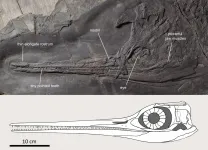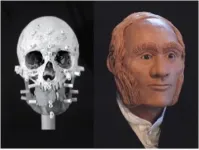INFORMATION:
Images:
Image 1: The first and most complete fossil of Besanosaurus leptorhynchus is a pregnant female (containing one embryo) on display at the Milan Natural History Museum, together with a fiberglass reconstruction of its in-life aspect. 16.500 hours of manual preparation were needed to expose the entire skeleton, embedded in a 330x270 cm black shale layer. Credit: Gabriele
Bindellini, © Museo di Storia Naturale di Milano.
Image 2: The skull of the type specimen of Besanosaurus leptorhynchus is characterized by extreme longirostry (i.e., thin elongate snout), and equipped with tiny pointed teeth, perfect for catching small fish and extinct cousins of squids with rapid snapping moves of the head and jaws. Credits: Gabriele Bindellini and Marco Auditore, © Museo di Storia Naturale di Milano.
Image 3: A view of Lake Lugano from Monte San Giorgio, between Lombardy (Italy, left) and Canton Ticino (Switzerland, right). Ichthyosaurs are among the most abundant fossils of this UNESCO World Heritage locality, which protects a unique paleo-biodiversity dating back to the Middle Triassic (240 million of years ago). Credit: Gabriele Bindellini.
Image 4: At the Zurich Institute and Museum of Paleontology, Gabriele Bindellini measures the orbital diameter of a subadult Besanosaurus leptorhynchus. This fossil preserves some three-dimensional anatomy, which helped to re-define the "identity card" of the species. Credit: Cristiano Dal Sasso.
Image 5: At the Zurich Institute and Museum of Paleontology, Cristiano Dal Sasso opens the display case of a remarkably large ichthyosaur specimen that, if complete, would have measured 8 meters in length. Although disarticulated, the skull indicates it is another Besanosaurus... Credit: Gabriele Bindellini.
Image 6: Reconstruction of Besanosaurus. In spite of their fish-like aspect, ichthyosaurs were reptiles. They were perfectly adapted to marine life through large modifications of their land-dwelling ancestors' limbs into paddles. Dorsal fins and crescentic tails also developed in later, more advanced forms. Pencil by Fabio Fogliazza digitally modified by Gabriele Bindellini, © Museo di Storia Naturale di Milano.
Image 7. The "Sasso Caldo" site, near Besano (Varese, Italy) in 1995. This outcrop is characterized by a regular alternance of thin black bituminous shales, and thicker grey-whitish dolomitized layers. Fossils are found in both, although in the shales the specimens are highly deformed. Photo by Giorgio Teruzzi, © Museo di Storia Naturale di Milano.
Image 8. Spring 1993, Besano (Varese, Italy): a snapshot of the recovery of the most complete specimen of Besanosaurus leptorhynchus. To avoid damaging the fossil, the bones of the large ichthyosaur were detected in cross-section, along the cuts of the slabs, without splitting the layer that embedded them firmly. The chisels in the photo were used only to detach the fossil-bearing layer from the underlying one. Photo by Cristiano Dal Sasso, © Museo di Storia Naturale di Milano.
Image 9. At the Fondazione Ospedale Maggiore di Milano, on the CT screen appears the Besanosaurus skull, with the orbital cavity (bottom center) surrounded by the bones of the temporal region. Photo by Cristiano Dal Sasso.
Image 10. At the Natural History Museum of Milan, the preparators of the Laboratory of Paleontology remove the silicon layer that, poured on the recomposed skeleton of Besanosaurus leptorhynchus, allows to produce identical replicas of the original fossil. © Photo by Guido Alberto Rossi and Museo di Storia Naturale di Milano.
Image 11. In the thoracic region of the Milan Besanosaurus, where the stomach was located, food remains are preserved, including this tiny hooklet from a squid relative's arm. Cephalopods were preferred prey for several species of ichthyosaurs. Photo by Gabriele Bindellini, © Museo di Storia Naturale di Milano.
Image 12. The "Sasso Caldo" site of Besano (Varese, Italy) as it appears today. The outcrop is extremely rich in fossils in almost every rock layer. In this picture, paleontologist Cristiano Dal Sasso indicates with his right hand the bituminous layer n. 65, in which the former Besanosaurus was embedded, and with his left hand the layer n. 63, which provided two small ichthyosaurs of the genus Mixosaurus. Photo by Gabriele Bindellini.
Image 13. At the Fondazione Ospedale Maggiore di Milano, paleontologist Gabriele Bindellini (left) and a student of the Degree in Medical Techniques of Radiology, Alessandro Crasti (right), scan the skull of Besanosaurus leptorhynchus before shifting it into the CT ring. Photo by Cristiano Dal Sasso.
Image 14. At the Institute and Museum of Paleontology of the Zurich University, paleontologists Cristiano Dal Sasso (left) and Torsten Scheyer (right) chat in front of the largest Besanosaurus - recently identified as such - unearthed in the first half of the last century from Swiss mines of Monte San Giorgio. If complete, this specimen would have approached 8 meters in length. Photo by Gabriele Bindellini.
CONTACTS
Dr. Cristiano Dal Sasso
Sezione di Paleontologia dei Vertebrati
Museo di Storia Naturale di Milano
Corso Venezia 55 - Milano 20121
Tel. 02 88463301
Email: cristiano.dalsasso@comune.milano.it
Dr. Gabriele Bindellini
Dipartimento di Scienze della Terra "Ardito Desio"
Università degli Studi di Milano
Tel. 349 6220170
Email: gabriele.bindellini@unimi.it
Full Media Pack including images and videos and extended press releases in ENGLISH and ITALIAN:
https://drive.google.com/drive/folders/1T11geolVBUCNBkDQxHePJwNIzG_D_mUM?usp=sharing
About:
PeerJ is an Open Access publisher of seven peer-reviewed journals covering biology, environmental sciences, computer sciences, and chemistry. With an emphasis on high-quality and efficient peer review, PeerJ's mission is to give researchers the publishing tools and services they want with a unique and exciting experience. All works published by PeerJ are Open Access and published using a Creative Commons license (CC-BY 4.0). PeerJ is based in San Diego, CA and the UK and can be accessed at peerj.com
PeerJ - the Journal of Life and Environmental Sciences is the peer-reviewed journal for Biology, Medicine and Environmental Sciences. PeerJ has recently added 15 areas in environmental science subject areas, including Natural Resource Management, Climate Change Biology, and Environmental Impacts.
peerj.com/environmental-sciences
Across its journals, PeerJ has an Editorial Board of over 2,000 respected academics, including 5 Nobel Laureates. PeerJ was the recipient of the 2013 ALPSP Award for Publishing Innovation. PeerJ Media Resources (including logos) can be found at: peerj.com/about/press
Media Contacts
For PeerJ: email: press@peerj.com , https://peerj.com/about/press/
Note: If you would like to join the PeerJ Press Release list, please register at: http://bit.ly/PressList
Slender-snouted Besanosaurus was an 8 m long marine snapper
Paleontologists working in museum collections in Italy, Switzerland, and Germany have identified five additional specimens of a 240-million-year-old ichthyosaur, named Besanosaurus leptorhynchus, which was previously known from a single fossil housed
2021-05-06
(Press-News.org) Middle Triassic ichthyosaurs are rare, and mostly small in size. The new Besanosaurus specimens described in the peer-reviewed journal PeerJ - the Journal of Life and Environmental Sciences - by Italian, Swiss, Dutch and Polish paleontologists provide new information on the anatomy of this fish-like ancient reptile, revealing its diet and exceptionally large adult size: up to 8 meters, a real record among all marine predators of this geological epoch. In fact, Besanosaurus is the earliest large-sized marine diapsid - the group to which lizards, snakes, crocodiles, and their extinct cousins belong to - with a long and narrow snout.
Besanosaurus leptorhynchus was originally discovered near Besano (Italy) three decades ago, during systematic excavations led by the Natural History Museum of Milan. The PeerJ article re-examines its skull bones in detail and assigns five additional fossils to this species: two previously undescribed fossil specimens, and two fossils previously referred to a different species (Mikadocephalus gracilirostris), which turns out to be not valid due to lack of significant anatomical differences with Besanosaurus.
The six specimens vary mainly in size and likely represent different growth stages. According to this re-analysis, Besanosaurus is the oldest and basal-most representative of a group of ichthyosaurs known as shastasaurids.
All specimens, housed in museums in Milan, Zurich, and Tübingen were collected in the last century from the bituminous black shales of the Monte San Giorgio area (Italy/Switzerland, UNESCO World Heritage), which were deposited some 240 million years ago at the oxygen-depleted bottom of a peculiar marine basin. The locality is famous worldwide for its rich fossil fauna that, besides ichthyosaurs, includes many other marine and semiaquatic reptiles, a variety of fish, and hard-shelled invertebrates.
"The extremely long and slender rostrum suggests that Besanosaurus primarily fed on small and elusive prey, feeding lower in the food web than an apex predator: a novel ecological specialisation never reported before this epoch of the Triassic in a large diapsid reptile. This might have triggered an increase of body size and lowered competition among the diverse ichthyosaurs that co-existed in this part of the Tethys Ocean", says Gabriele Bindellini of the Earth Science Dept. of Milan University, first author of this study.
"Studying these fossils was a real challenge. All Besanosaurus specimens have been extremely compressed by deep time and rock pressure, so we used advanced medical CT scanning, photogrammetry techniques and comparisons with other ichthyosaurs to reveal their hidden anatomy and reconstruct their skulls in 3D, bone by bone", remarks Cristiano Dal Sasso of the Natural History Museum of Milan, senior author of the PeerJ article, who in 1996 originally described and named Besanosaurus.
Interestingly, the Italian researchers started re-studying the Milan Besanosaurus roughly at the same time an international team including Andrzej Wolniewicz (IP PAS, Warsaw), Feiko Miedema (SMNS, Stuttgart), and Torsten Scheyer (UZH, Zurich) started working on the Swiss specimens. "Rather than doing parallel studies, we pooled our data and efforts and pulled on the same string, to enhance our understanding of these fascinating extinct animals", adds Torsten Scheyer.
ELSE PRESS RELEASES FROM THIS DATE:
Novel biomarker linked to hair loss can determine COVID severity in men
2021-05-06
LUGANO, 6 May, 2021- Researchers have discovered a novel biomarker to identify male COVID-19 patients most at risk for ICU admission. The findings presented today at EADV's 2021 Spring Symposium, suggest that men with genetic characteristics (phenotypes) sensitive to the male sex hormone androgen, are more likely to experience severe COVID-19 disease.
Researchers were driven to study the association between the androgen receptor (AR) gene and COVID-19, after observing the disproportionate number of men hospitalised with COVID-19 presenting with androgenetic alopecia (a common form of hair-loss) compared to the expected number in a similar age-matched population (79% vs. 31-53%).
Androgenetic alopecia is known to be controlled by variations ...
5:2 diet helps reduce skin symptoms in Psoriasis patients
2021-05-06
LUGANO, 6 May, 2021- New research investigating for the first time the effects of modified intermittent fasting (MIF) on the skin of people with psoriasis has yielded promising results. Preliminary study findings presented today at the EADV Spring Symposium, show a significant reduction in scaling and thickness in patients with mild psoriasis after following a MIF 5:2 diet (eating normally for 5 days and restricting calorie intake on 2 non-consecutive days).
Psoriasis is a chronic, systemic immune-mediated inflammatory disease that causes raised plaques and ...
Exercise aids the cognitive development of children born preterm
2021-05-06
A premature start in life can cause problems even into teenage years. A study by the University of Basel and the University Children's Hospital Basel (UKBB) indicates that training motor skills in these children helps even when they are older.
Children that are born before the 37th week of pregnancy remain under close medical supervision while they are young. Any cognitive limitations often disappear after a few years. However, children who come into the world even before the 32nd week of gestation still exhibit differences even into their teenage years. In a new study, researchers led by Dr. Sebastian Ludyga ...
Achieving high COVID-19 vaccine coverage levels by summer can prevent millions of cases
2021-05-06
(MAY 6, 2021) New York, NY - With around 30 percent of the U.S. population now fully vaccinated, the rate of daily vaccinations has started to slow, raising concerns that greater efforts and investments may be needed to reach higher coverage levels. A study published in the Journal of Infectious Diseases on May 6 shows the lives, hospitalizations, and costs that can be saved by even relatively small increases in vaccination coverage and reaching higher vaccination coverage levels sooner (e.g., by the end of the summer versus fall/winter).
The study was led by researchers from PHICOR (Public Health Informatics, Computational, and Operations Research) at CUNY Graduate School of Public ...
Many consumers misinterpret food date labels, yet use them with confidence
2021-05-06
Philadelphia, May 6, 2021 - Misunderstanding food date labeling is common and educational communications are needed to improve consumer understanding, according to a new study in the Journal of Nutrition Education and Behavior, published by Elsevier.
Does it mean "spoiled - throw it out," or "might not taste as good as it could anymore?" Food date labels (e.g., "USE By August 16") can play an important role in helping consumers make informed decisions about food, and ultimately prevent unsafe consumption and waste of food. Researchers surveyed 2,607 adults in the United States to assess consumer understanding of the streamlined 2-date ...
Open source tool can help identify gerrymandering in voting maps
2021-05-06
PULLMAN, Wash. -- With state legislatures nationwide preparing for the once-a-decade redrawing of voting districts, a research team has developed a better computational method to help identify improper gerrymandering designed to favor specific candidates or political parties.
In an article in the Harvard Data Science Review, the researchers describe the improved mathematical methodology of an open source tool called GerryChain. The tool can help observers detect gerrymandering in a voting district plan by creating a pool, or ensemble, of alternate maps that also meet legal voting criteria. This map ensemble can show ...
First member of ill-fated 1845 Franklin expedition is identified by DNA analysis
2021-05-06
The identity of the skeletal remains of a member of the 1845 Franklin expedition has been confirmed using DNA and genealogical analyses by a team of researchers from the University of Waterloo, Lakehead University, and Trent University. This is the first member of the ill-fated expedition to be positively identified through DNA.
DNA extracted from tooth and bone samples recovered in 2013 were confirmed to be the remains of Warrant Officer John Gregory, engineer aboard HMS Erebus. The results matched a DNA sample obtained from a direct descendant of Gregory.
The remains of the officer were found on King William Island, Nunavut. "We now know that John Gregory was one of three expedition personnel who ...
We need to build more EV fast-charging stations, researchers say
2021-05-06
A team of engineers recommends expanding fast-charging stations for electric vehicles as campuses and businesses start planning for a post-pandemic world.
The recommendation is based on a study of charging patterns for electric vehicles on the University of California San Diego campus from early January to late May of 2020, after the university moved most of its operations online. Researchers say the findings can be applied to a broader range of settings.
"Workplace charging is a critical enabler of carbon-free transportation as the electrons consumed primarily come from solar power plants, as opposed to at-home charging, which occurs at night and relies more on fossil ...
Fear of losing health insurance keeps 1 in 6 workers in their jobs
2021-05-06
WASHINGTON, DC - MAY 6, 2021 - One out of every six adult workers (16%) in the United States are staying in jobs they might otherwise leave out of fear of losing their employer-sponsored health insurance, according to a new West Health-Gallup survey of more than 3,800 U.S. adults.
The survey finds the fear is even more pronounced among Black workers, who are 50% more likely to remain in an unwanted job than their White and Hispanic counterparts (21% to 14% and 16%, respectively).
But the most likely to stay in a job they would rather leave are those workers in households earning less than $48,000 a year -- roughly 3 in 10 (28%) say they will not leave and risk losing their health benefits. Workers in lower income households are nearly ...
Breathing problems are the second most common symptom of heart attacks
2021-05-06
Sophia Antipolis, 6 May 2021: One in four heart attack patients have atypical symptoms such as breathing difficulties, extreme exhaustion, and abdominal pain, according to a study published today in European Heart Journal - Acute Cardiovascular Care, a journal of the European Society of Cardiology (ESC).1 Patients with atypical symptoms were less likely to receive emergency help and more likely to die within 30 days compared to those with chest pain.
"We found that atypical symptoms were most common among older people, especially women, who called a non-emergency helpline for assistance," said study author Ms. Amalie Lykkemark Møller, PhD student, Nordsjællands Hospital, ...
LAST 30 PRESS RELEASES:
Interaction of climate change and human activity and its impact on plant diversity in Qinghai-Tibet plateau
From addressing uncertainty to national strategy: an interpretation of Professor Lim Siong Guan’s views
Clinical trials on AI language model use in digestive healthcare
Scientists improve robotic visual–inertial trajectory localization accuracy using cross-modal interaction and selection techniques
Correlation between cancer cachexia and immune-related adverse events in HCC
Human adipose tissue: a new source for functional organoids
Metro lines double as freight highways during off-peak hours, Beijing study shows
Biomedical functions and applications of nanomaterials in tumor diagnosis and treatment: perspectives from ophthalmic oncology
3D imaging unveils how passivation improves perovskite solar cell performance
Enriching framework Al sites in 8-membered rings of Cu-SSZ-39 zeolite to enhance low-temperature ammonia selective catalytic reduction performance
AI-powered RNA drug development: a new frontier in therapeutics
Decoupling the HOR enhancement on PtRu: Dynamically matching interfacial water to reaction coordinates
Sulfur isn’t poisonous when it synergistically acts with phosphine in olefins hydroformylation
URI researchers uncover molecular mechanisms behind speciation in corals
Chitin based carbon aerogel offers a cleaner way to store thermal energy
Tracing hidden sources of nitrate pollution in rapidly changing rural urban landscapes
Viruses on plastic pollution may quietly accelerate the spread of antibiotic resistance
Three UH Rainbow Babies & Children’s faculty elected to prestigious American Pediatric Society
Tunnel resilience models unveiled to aid post-earthquake recovery
Satellite communication systems: the future of 5G/6G connectivity
Space computing power networks: a new frontier for satellite technologies
Experiments advance potential of protein that makes hydrogen sulfide as a therapeutic target for Alzheimer’s disease
Examining private equity’s role in fertility care
Current Molecular Pharmacology achieves a landmark: real-time CiteScore advances to 7.2
Skeletal muscle epigenetic clocks developed using postmortem tissue from an Asian population
Estimating unemployment rates with social media data
Climate policies can backfire by eroding “green” values, study finds
Too much screen time too soon? A*STAR study links infant screen exposure to brain changes and teen anxiety
Global psychiatry mourns Professor Dan Stein, visionary who transformed mental health science across Africa and beyond
KIST develops eco-friendly palladium recovery technology to safeguard resource security
[Press-News.org] Slender-snouted Besanosaurus was an 8 m long marine snapperPaleontologists working in museum collections in Italy, Switzerland, and Germany have identified five additional specimens of a 240-million-year-old ichthyosaur, named Besanosaurus leptorhynchus, which was previously known from a single fossil housed





